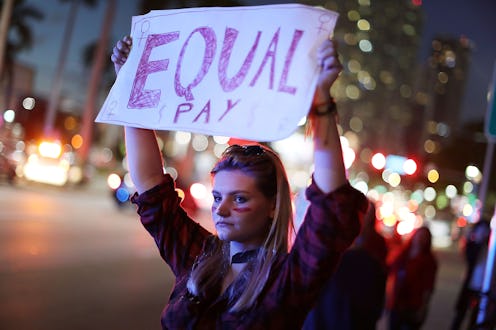
The National Women's Law Center released its findings on the American lifetime wage gap, and it's appalling. The resource provides a state-by-state comparison of the lifetime wage gap for women compared to men, and that gap is present in every state in the United States, according to the NWLC. Based on present numbers, the gap culminates to nearly $250,000 in most states. However, the chasm is even more pronounced and exacerbated in certain states.
In Montana, North Dakota, Wyoming, Utah, Louisiana, Ohio, Michigan, New Hampshire, and West Virginia, the lifetime wage gap reaches more than $500,000 over a woman's 40-year career compared to male counterparts working for the same amount of time. For instance, in the case of Wyoming, the NWLC states that "a woman would have to work until she is 82 years old to make what a man makes by the time he is 60 years old."
The NWLC further differentiates numbers based on the lifetime wage gap for women from different racial and ethnic demographics. According to the data, based on today's wage gap, women in America "lose $418,800 over the course of a 40-year career" compared to men. However, Black women lose an average of $840,040, while Latinas lose $1,043,800 over the course of their careers.
The gap is absolutely harrowing for women of color. In one particularly disturbing example, the NWLC indicates that today's wage gap could culminate in a loss of $1,045,000 for a Black woman working in California for four decades, compared to a white, non-Hispanic man. The situation is no better in Utah, Texas, Louisiana, New Jersey, Connecticut, or Massachusetts.
The wage gap is dire for Latinas in 22 states, where they would have to work well past age 90 to make up for losses. But the map goes further to show that Latinas would have to work past age 100 to cover losses accrued under the lifetime wage gap in 13 states, including Texas, California, Utah, Illinois, Massachusetts, New Jersey, and Washington, D.C., which the center considered a state for the purposes of analysis.
Similar rifts show for Native women. In the case of New Jersey, a Native woman loses $1,333,400 over a 40-year career compared to a white, non-Hispanic man. She would have to work until she is 93 years old to be earning what her white male counterpart would achieve by the time he is 60 years old.
Asian women face the most stringent lifetime wage gaps in California, Louisiana, D.C., and Vermont. In the case of Alaska, an Asian woman loses $1,229,600 over a 40-year career compared to her white, non-Hispanic male peer.
Women are much more likely to be exposed to poverty compared to men. Over the years, according to the National Women's Law Center, poverty among women aged 65 and over has only increased. The consequences of the lifetime wage gap are not limited to a woman's present income — they are far-reaching and undeniable. The gap, over time, devastates a woman's retirement savings, health care costs, and life expectancy by rendering her socially vulnerable without a robust financial plan for her life. A report in ThinkProgress shows how the wage gap, over a lifetime, exposes women to foreclosure, scams, and other sources of financial upheaval in their senior years.
Without equal pay, working American women remain woefully neglected and potentially stultified by the lifetime wage gap present in every single state. After all, the productivity and happiness of a country's collective workforce is directly dependent on how it compensates the labor of its workers, regardless of their gender and race.